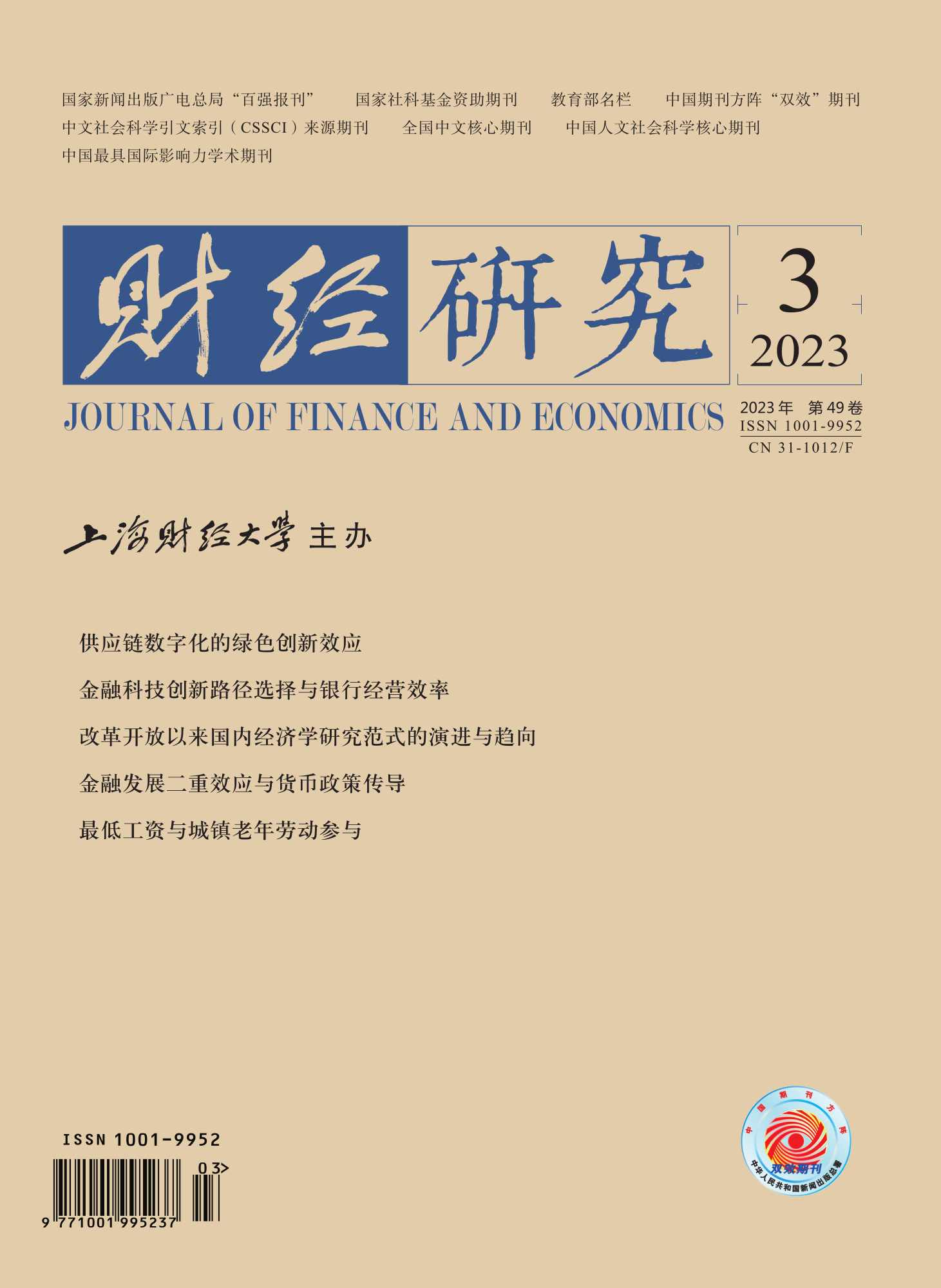文章以1978—2017年“中国知网”数据库收录的400篇高频被引文献为样本,重点挖掘其中的“睡美人”“昙花一现”两类特殊的引文现象,以此说明改革开放以来国内经济学研究范式的演进历程与未来趋向。结果表明:(1)国内经济学研究具有鲜明的多层化结构,“睡美人”和“昙花一现”两者分别对应着多层化结构中的边缘和主流研究,生动展现了改革开放四十余年来经济学主流研究范式深刻而迅速的转型。(2)从转型特征来看,国内经济学的研究重心与现实经济改革的焦点始终高度契合,但对时空跨度选取趋于明晰化,研究方法趋于定量化和数学化。上述新特征均在“睡美人”文献中率先出现,表明国内经济学研究范式的演进历程不是对国际学界的盲目照搬和追随,而是具有显著的自觉性与连续性。(3)从转型动因来看,由研究主体和阵地组成的学术共同体在这一历程中扮演了至关重要的角色。在研究主体方面,高频被引文献的作者趋向于年轻化、规模化和背景交叉化;在研究阵地方面,高校、科研机构和学术期刊的极化现象均有所减弱。上述趋向显著推动了经济学研究范式的新旧更迭,为原创性理论和成果的出现铺就了道路。
改革开放以来国内经济学研究范式的演进与趋向——以高频被引文献中的“睡美人”“昙花一现”现象为例
摘要
参考文献
2 顾海良. 从“第二次结合”到“系统化的经济学说”−新中国70年社会主义政治经济学“历史路标”论略[J]. 学习与探索,2019,(8):5−15. DOI:10.3969/j.issn.1002-462X.2019.08.003
5 洪永淼, 汪寿阳. 大数据如何改变经济学研究范式?[J]. 管理世界,2021,(10):40−55. DOI:10.3969/j.issn.1002-5502.2021.10.004
6 金碚. 论中国特色社会主义经济学的范式承诺[J]. 管理世界,2020,(9):11−17. DOI:10.3969/j.issn.1002-5502.2020.09.003
7 劳伦斯·A·博兰. 批判的经济学方法论[M]. 王铁生等译. 北京: 经济科学出版社, 2000.
8 李品保, 王幼军. 科学“睡美人”现象研究−以数学史主题论文为中心[J]. 科学与管理,2020,(4):84−88. DOI:10.3969/j.issn.1003-8256.2020.04.012
12 林毅夫. 关于经济学方法论的对话[J]. 东岳论丛,2004,(5):5−30. DOI:10.3969/j.issn.1003-8353.2004.05.001
17 马克·布劳格. 经济学方法论的新趋势[M]. 张大宝等译. 北京: 经济科学出版社, 2000.
25 杨建飞. 科学哲学对西方经济学思想演化发展的影响[M]. 北京: 商务印书馆, 2004.
26 俞立平. 大数据与大数据经济学[J]. 中国软科学,2013,(7):177−183. DOI:10.3969/j.issn.1002-9753.2013.07.017
27 张卓元. 中国经济学60年(1949—2009)[M]. 北京: 中国社会科学出版社, 2009.
29 Angrist J, Azoulay P, Ellison G, et al. Economic research evolves: Fields and styles[J]. American Economic Review,2017,107(5): 293−297. DOI:10.1257/aer.p20171117
30 Angrist J D, Pischke J S. The credibility revolution in empirical economics: How better research design is taking the con out of econometrics[J]. Journal of Economic Perspectives,2010,24(2): 3−30. DOI:10.1257/jep.24.2.3
31 Barber B. Resistance by scientists to scientific discovery: This source of resistance has yet to be given the scrutiny accorded religious and ideological sources[J]. Science,1961,134(3479): 596−602. DOI:10.1126/science.134.3479.596
32 Burrell Q L. Are “sleeping beauties” to be expected?[J]. Scientometrics,2005,65(3): 381−389. DOI:10.1007/s11192-005-0280-5
33 Bush W C, Hamelman P W, Staaf R J. A quality index for economic journals[J]. The Review of Economics and Statistics,1974,56(1): 123−125. DOI:10.2307/1927541
34 Camerer C F, Dreber A, Holzmeister F, et al. Evaluating the replicability of social science experiments in nature and science between 2010 and 2015[J]. Nature Human Behaviour,2018,2(9): 637−644. DOI:10.1038/s41562-018-0399-z
35 Campanario J M. Rejecting and resisting Nobel class discoveries: Accounts by Nobel laureates[J]. Scientometrics,2009,81(2): 549−565. DOI:10.1007/s11192-008-2141-5
36 Cole S. Professional standing and the reception of scientific discoveries[J]. American Journal of Sociology,1970,76(2): 286−306. DOI:10.1086/224934
37 Dequech D. Some institutions (social norms and conventions) of contemporary mainstream economics, macroeconomics and financial economics[J]. Cambridge Journal of Economics,2017,41(6): 1627−1652. DOI:10.1093/cje/bex014
38 Egghe L, Guns R, Rousseau R. Thoughts on uncitedness: Nobel laureates and fields medalists as case studies[J]. Journal of the American Society for Information Science and Technology,2011,62(8): 1637−1644. DOI:10.1002/asi.21557
40 Glänzel W, Schlemmer B, Thijs B. Better late than never? On the chance to become highly cited only beyond the standard bibliometric time horizon[J]. Scientometrics,2003,58(3): 571−586. DOI:10.1023/B:SCIE.0000006881.30700.ea
41 Hamermesh D S. Six decades of top economics publishing: Who and how?[J]. Journal of Economic Literature,2013,51(1): 162−172. DOI:10.1257/jel.51.1.162
42 Henriksen D. The rise in co-authorship in the social sciences (1980-2013)[J]. Scientometrics,2016,107(2): 455−476. DOI:10.1007/s11192-016-1849-x
43 Hodgson G M, Rothman H. The editors and authors of economics journals: A case of institutional oligopoly?[J]. The Economic Journal,1999,109(453): 165−186. DOI:10.1111/1468-0297.00407
44 Hudson J. Trends in multi-authored papers in economics[J]. Journal of Economic Perspectives,1996,10(3): 153−158. DOI:10.1257/jep.10.3.153
45 Lange L L. Sleeping beauties in psychology: Comparisons of “hits” and “missed signals” in psychological journals[J]. History of Psychology,2005,8(2): 194−217. DOI:10.1037/1093-4510.8.2.194
46 Oromaner M. Professional standing and the reception of contributions to economics[J]. Research in Higher Education,1983,19(3): 351−362. DOI:10.1007/BF00976512
47 Pieters R, Baumgartner H. Who talks to whom? Intra -and interdisciplinary communication of economics journals[J]. Journal of Economic Literature,2002,40(2): 483−509. DOI:10.1257/jel.40.2.483
48 Romer P M. Mathiness in the theory of economic growth[J]. American Economic Review,2015,105(5): 89−93. DOI:10.1257/aer.p20151066
49 Seglen P O. Why the impact factor of journals should not be used for evaluating research[J]. BMJ,1997,314(7079): 498−502. DOI:10.1136/bmj.314.7079.498
50 Seltzer A J, Hamermesh D S. Co-authorship in economic history and economics: Are we any different?[J]. Explorations in Economic History,2018,69: 102−109. DOI:10.1016/j.eeh.2018.04.001
51 Stigler G J, Stigler S M, Friedland C. The journals of economics[J]. Journal of Political Economy,1995,103(2): 331−359. DOI:10.1086/261986
52 Van Raan A F J. Sleeping beauties in science[J]. Scientometrics,2004,59(3): 467−472. DOI:10.1023/B:SCIE.0000018543.82441.f1
53 Van Dalen H P, Henkens K. Signals in science - On the importance of signaling in gaining attention in science[J]. Scientometrics,2005,64(2): 209−233. DOI:10.1007/s11192-005-0248-5
引用本文
张亚光, 毕悦. 改革开放以来国内经济学研究范式的演进与趋向——以高频被引文献中的“睡美人”“昙花一现”现象为例[J]. 财经研究, 2023, 49(3): 49-63.
导出参考文献,格式为:





 6971
6971  6487
6487

